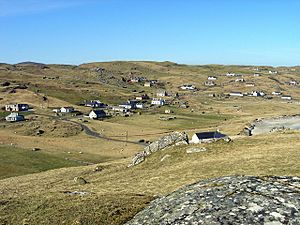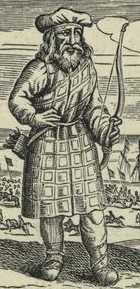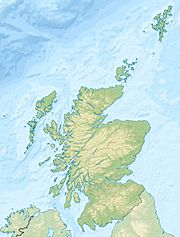Macaulay family of Lewis facts for kids
The Macaulay family of Uig in Lewis, known in Scottish Gaelic as Clann mhic Amhlaigh, was a small family group, or clan, living around Uig on the Isle of Lewis in the Outer Hebrides of Scotland. It is important to know that these Macaulays are not connected to Clan MacAulay from the Loch Lomond area.
People often think the Macaulays of Lewis came from Norse (Viking) backgrounds. This is because their name sounds Norse, and the islands had a strong Viking Age past. However, recent Y-DNA studies show that many Hebridean Macaulays actually have Irish roots. In the 1600s, old stories also said they were from Ireland or were Gaelic.
By the late 1500s, the most powerful clan on Lewis was Clan Macleod of The Lewes. Other important clans were the Morrisons of Ness and the smaller Macaulays of Uig. The Macaulays lived on the western coast of Lewis. They had a long and deadly feud with the Morrisons, whose lands were in the north around Ness. Today, the Lewis surname Macaulay is seen as a sept name of the Macleods of Lewis. This means they are considered part of the larger Macleod clan. There are also two other Macaulay groups nearby, in Wester Ross and Uist, who may or may not be related to the Lewis Macaulays.
Contents
Where Did the Macaulays Come From?
The Name Macaulay and Norse Influence
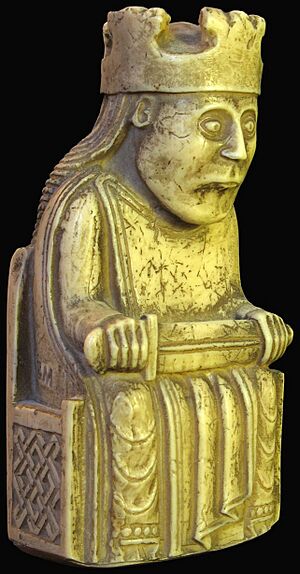
The name Macaulay in the Scottish Hebrides comes from the Scottish Gaelic MacAmhlaidh. This means "son of Amhlaidh." These names come from the Old Norse names Áleifr and Óláfr. The name Óláfr means "ancestor's heir." It was a very common name among the Vikings. It was also the name of Saint Olaf (995–1030), an early king of Norway who helped spread Christianity.
The names of people and places can tell us about how much the Norse influenced Scotland's islands and coasts. From the Viking Age onwards, the Hebrides were called Innse Gall by the Gaels. This means "Isles of the Foreigners" (Norse). Many village names in Lewis and Skye are purely Norse. This shows how strong the Norse presence was there.
A recent Y-DNA study of men with Scottish surnames found something interesting. A large group of men named Macaulay, many from Lewis and Harris, have their genetic roots in southwest Ireland. This specific Y-DNA marker is very rare in Scotland. It is only found in the Western Isles and Northern Isles. One idea is that this marker might belong to Irish slaves brought to Scotland by the Vikings. This could explain why an Irish marker is found in areas where Vikings were active, and why it is carried by Scots with Norse-sounding names.
Old Stories About the Clan's Beginnings
Old stories say that most West Highland clans started around the 1200s. At that time, Lewis was controlled by the Norse. The Chronicles of Mann mention an important Óláfr connected to Lewis: Olaf the Black, who later became King of Man and the Isles. Today, many believe the Macaulays of Lewis are descended from Olaf the Black. However, there is no real proof that his descendants lived on Lewis.
Another tradition says the Macaulays of Uig came from "Magnus, King of Norway." The famous historian Lord Macaulay, also a descendant, called him "Olaus Magnus, King of Norway." The name Magnus might be important because Olaf the Black had a son named Magnus.
In the 1600s, people on Lewis believed the Macaulays came from an Irishman. This was written down by John Morrison of Bragar, known as the 'Indweller' of Lewis. His own mother was a Macaulay. The Indweller wrote that the first people on Lewis were three men from different backgrounds. One was "Iskair Mac.Awlay ane Irish man whose posteritie remain likvise to this day in the Lews."
The first and most antient Inhabitants of this Countrie were three men of three severall races viz. Mores the son of Kenannus whom the Irish historiance call Makurich whom they make to be Naturall Sone to one of the Kings of Noruvay. some of whose posteritie remains in the land to this day. All Morisones in Scotland may challenge there descent from this man. The second was Iskair Mac.Awlay ane Irish man whose posteritie remain likvise to this day in the Lews. The third was Macknaicle whose onlie daughter Torquill the first of that name (and sone to Claudius the sone of Olipheous, who likvise is said to be the King of Noruway his sone,) did violentlie espouse, and cutt off Immediatlie the whole race of Macknaicle and possessed himself with the whole Lews and continueth to his posteritie (Macleud of Lews) dureing 13 or 14 generations and so extinct before, or at least about the year 1600 the maner of his decay I omitt because I intend no historie but a descriptione.
The name Iskair is Sgàire in Scottish Gaelic. This old Gaelic name is special to the Macaulays of Lewis. It is still used by the clan today. It might come from the Old Norse word skári, meaning "sea mew" (a type of bird). The Indweller's story did not mention a royal ancestry for the Macaulays, but gave them an Irish one. Some historians think that when the Indweller wrote "Irishman" in the 1600s, he meant "Gaelic" or "Gael".
First Macaulays on Record
The first Macaulay of Lewis mentioned in official records might be Dòmhnall Cam in 1610. However, two Macaulays seem to have witnessed a land document in 1572. Their names were "Johanno roy [mcRore] mcLachlayne McOler" and "Murdo mcRorie mcLachlayne." The name McOler likely means Macaulay, suggesting they were Uig Macaulays.
Island Conflicts and Feuds
The Massacre of the Macaulays
Stories on Lewis tell of a terrible event where the Macaulays were massacred by the Macleods in the 1400s or 1500s. The Macaulays lived on farms in Reef, Valtos, and Kneep in Uig. These farms were next to lands held by Tormod Mòr, brother of the Macleod chief of Lewis. A fight over cattle led to Tormod Mòr being hurt. In revenge, his sons led Macleod clansmen to kill almost every Macaulay they could find. The only survivors were said to be the chief's youngest son, Iain Ruadh, and his half-brother.
The Macaulays and Morrisons also had continuous feuds. One big clan battle is said to have happened near Barvas. It is marked by the 18 feet 10 inches (5.74 m) tall standing stone Clach an Trushal. People say the Morrisons put it there to celebrate their victory. However, historians think this part of the story is unlikely. The stone was probably part of a stone circle, like the nearby Callanish Stones.
The Brahan Seer's Prophecy
|
It is on the day Allt nan Torcan |
| A prophecy attributed to the Brahan Seer, translated by Rev. William Matheson. |
Coinneach Odhar, also known as the Brahan Seer, was a famous Highland prophet. One of his many predictions involves the Macaulays of Lewis (see box on the right). This prophecy might describe the battle where the Macaulays were massacred by the Macleods.
Dòmhnall Cam, the One-Eyed Hero
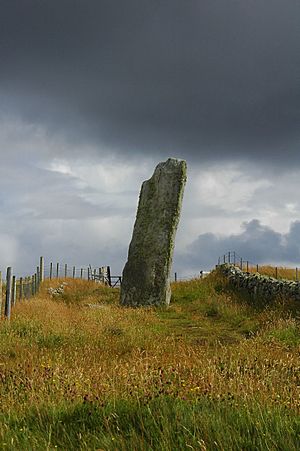
The most famous Macaulay was Dòmhnall Cam (about 1560 – 1640). His Gaelic nickname cam means "squint" or "blind in one eye." Stories say Dòmhnall Cam lost his eye in a fight with the smith of Kneep, who used a red-hot poker. Several places on Lewis are named after him, including a shieling (a summer hut for herders) and a sea stack where he supposedly hid. Dòmhnall Cam was known as a fierce fighter with a quick temper.
Tradition says Dòmhnall Cam fought as a mercenary in Ireland. He became famous there after winning a duel against a champion called "the Great McBane."
When he returned to Lewis, Dòmhnall Cam was involved in violent feuds with the Morrisons and later the Mackenzies. He helped Neil Macleod capture Stornoway Castle in 1607. During this fight, Dòmhnall's brother was killed.
One famous story tells of a raid by the Morrisons of Ness into Macaulay land. The Morrisons stole Macaulay cattle. Dòmhnall Cam, Big Smith, and other Macaulays chased them across Loch Roag to Dun Carloway. Dòmhnall Cam killed the guard and blocked the exits. He then climbed the walls of the broch (an ancient stone tower) using two dirks. Once inside, he ordered his men to throw bundles of heather down onto the Morrisons. Dòmhnall Cam then set the heather on fire, which killed the Morrisons and destroyed Dun Carloway.
The Mackenzie Conquest of Lewis
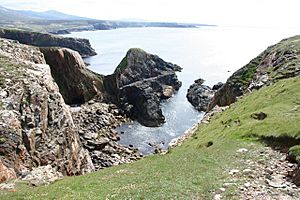
In the early 1600s, the Scottish government saw the Outer Hebrides as wild and lawless. King James VI encouraged a group of "Adventurers" from Fife to colonize Lewis. They tried three times but failed. The islanders fought back and drove them out.
In 1610, the Adventurers sold their rights to Kenneth Mackenzie of Kintail. Within two years, the Mackenzies succeeded in taking control of the island. During this time, the Macaulays fought alongside the Macleods of Lewis against the Mackenzie invaders.
Even after the Mackenzies took control, some islanders, like Neil MacLeod and Dòmhnall Cam, continued to resist. Tradition says Dòmhnall Cam fortified himself on a 100-foot (30 m) high rock called Stac Dhòmhnaill Chaim near Mangursta. His daughter, Anna Mhòr ("Big Anne"), supposedly carried water to him on her head, needing her hands to climb the cliffs.
Later Battles: Auldearn and the Last Clan Fight
In 1645, many Lewismen, including Macaulays, fought in the Battle of Auldearn as part of the Covenanters army. They suffered a huge defeat. Of the 300 Lewismen who went to battle, only 3 returned. Sixty of them were from Uig, the Macaulay heartland. The only Uig survivor was John Macaulay (Iain Ruadh), another son of Dòmhnall Cam. Dòmhnall Cam's youngest son, William, was killed.
According to local stories, the last big clan battle between the Macaulays and Morrisons happened in 1654. It supposedly started when Uig Macaulays stole cattle from Ness Morrisons. The battle took place near Barvas. The number of dead is unknown, but tradition says they were buried there, with cairns marking their graves.
1700s: Jacobite Rebellions
As tenants of the Earl of Seaforth, the Lewis clans, including the Macaulays, followed Clan Mackenzie. In 1715, William Mackenzie, 5th Earl of Seaforth supported the Jacobites (who wanted to restore the Stuart kings). Many Lewismen, including several Macaulays, were officers in his army. The rebellion failed, and Seaforth lost his title. His tenants suffered greatly.
The Lewis Macaulays did not support the Jacobites in the 1745–46 rebellion. After the Jacobite defeat at the Battle of Culloden, Charles Edward Stuart (Bonnie Prince Charlie) fled to the Hebrides. Several Lewis Macaulays helped the government try to catch him. Rev. John Macaulay, a Presbyterian minister, discovered Stuart's plans and warned his father, Rev. Aulay Macaulay, a strong supporter of the Hanoverian king. Rev. Aulay almost caught Stuart on Scalpay.
1800s: Evictions and Emigration
The Highland Clearances also affected Lewis, though not as severely as other parts of the Highlands. Many villages in Uig were emptied. In the early 1800s, the Earl of Seaforth tried to evict up to 1,000 people from Uig and Lochs. He wanted them to move to Stornoway and Barvas and work in his proposed fishery. Many people were forced from their homes. For example, in 1838, Mealista, the largest village in West Uig, was cleared, and most of its people went to Canada.
The potato crop failed in 1845 and 1846, causing great hardship. The new owner of Lewis, Sir James Matheson, offered to pay for poor people to move to the Canadian provinces of Ontario and Quebec. Many Lewis families, including Macaulays, took this offer and settled in Quebec.
Famous Descendants
Several notable people trace their family back to the Lewis folk-hero Dòmhnall Cam. He had at least three sons: Angus of Brenish, John of Kneep, and William of Islivig.
- Angus was killed at the Battle of Auldearn in 1645. His descendants include:
* Zachary Macaulay (1768–1838), a colonial governor and a leader in the movement to end slavery. * Thomas Babington Macaulay, 1st Baron Macaulay, a famous historian and politician, who was Zachary's son. * Rose Macaulay (1881–1958), a well-known English writer. * Robertson Macaulay (1833–1915), who moved to Canada and became president of Sun Life insurance company. His son, Thomas Bassett Macaulay, was also chairman of Sun Life and gave money to institutions on Lewis.
- John, tacksman of Kneep, was one of only three Lewismen who survived the Battle of Auldearn.
- William, tacksman of Islivig, was killed at the Battle of Auldearn. He was the youngest of Dòmhnall Cam's known sons.
- Captain Murdo Stewart MacDonald, known as the last of the Sea-Barons, was also a direct descendant of Dòmhnall Cam.
Other Macaulay Clans Nearby
Uist MacAulays
There are MacAulays on the Uists who might be related to the Lewis Macaulays. However, some Uist MacAulays say they are not related to those on Lewis. Tradition says these MacAulays came from the "Athwart Islands" (possibly Rum, Eigg, and Canna, also known as the Small Isles). Some believe they originally came from the Lennox area near Loch Lomond and are related to the MacAulays of Ardincaple.
Wester Ross Macaulays
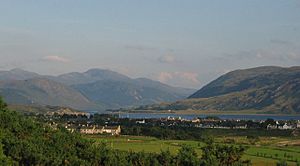
According to the Mackenzies' traditions, there were once Macaulays in Wester Ross (across the sea from Lewis). In the 1600s, Dr. George Mackenzie wrote that the Macaulays were ancient inhabitants of Kintail and were of Norwegian origin. He claimed they came from an Olaus, a relative of the King of Man, who was given lands in the Loch Broom area.
The name of the town Ullapool (Scottish Gaelic: Ulapul) might support the idea of Macaulays being in the area. Historians believe its name comes from Old Norse, possibly meaning "the homestead of Olaf" or "Ulli's farm."
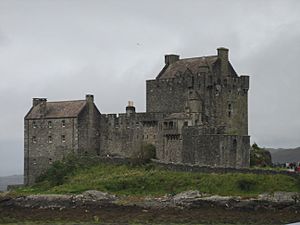
The Macaulays have also been linked to the Battle of Bealach nam Broig (battle of "the pass of the brogue"), fought around 1452. This battle involved various clans from Ross against the Earl of Ross's followers. Old records say that "Clan-t-aluigh, i.e., Clan-Aulay" was "utterlie extinguished and slain" in this battle.
A story from the late 1600s tells of a Macaulay who was the constable of Eilean Donan castle. He was tricked into giving up the castle but later managed to retake it. He then used a prisoner to force the release of Mackenzie, who had been captured.
After this, the history of the Wester Ross Macaulays became closely tied to the Mackenzies. There are no more separate records of them. This suggests they joined with the Mackenzies. In 1725, George Wade, a military commander, ordered all Highlanders in the former Seaforth lands to give up their weapons. This included the Macaulays.
To all and every the Clans of the M'Kenzies, M'Ras, Murchiessons, M'Lays, M'Lennans, Mathewsons, M'Aulays, Morrisons, M'Leods, and all other Clans and persons liable by Act of Parliament to be disarmed within the limits of that part of the Estate formerly belonging- to the late Earl of Seaforth, in the parishes of Dingwell, Urquhart, Collyrndden, Rosemarky, Avoch, Suddy, Kilmure Wester, Killurnon, Luggy Wester, Urray, Contan, Totterery, Kintail, Loch Caron, Garloch, Loch Breyn, and Assint, and to all other persons inhabiting or being within the parishes, lands, limits, and boundings above-mentioned ...
Macaulay Population in the Hebrides and Wester Ross

In 1861, Lewis had a population of 21,059 people. The most common surname was Macleod (3,838 people), followed by Morrison (1,402). Macaulay was the ninth most common surname, with 727 people. On Harris, there were only 64 people named Macaulay. On North Uist, Macaulay was the third most common surname with 165 people. By 1961, Macaulay was the eleventh most common surname on Lewis, with about 500 people.
In 1901, the parish of Gairloch in Wester Ross had a population of 4,181. Of these, only 5 people were named Macaulay.
See also
- Mac Amhlaoibh and Mac Amhalghaidh, several Irish clans named after two Gaelic patronymic names that can both be Anglicised as Macaulay
- Macaulay, list of Wikipedia articles on people, places and things named Macaulay, MacAulay, McAulay
- Olvir Rosta, a character in the Orkneyinga saga, possibly associated with the Lewis Macaulays, or the MacLeods
Images for kids
-
Locations mentioned within the article (click to enlarge). The Lewis Macaulays were centred at Uig, on the Isle of Lewis. The Wester Ross Macaulays have been associated with Loch Broom and Ullapool. The Uist MacAulays were centred on the Uists; though they were said to have incomers from the Small Isles.


